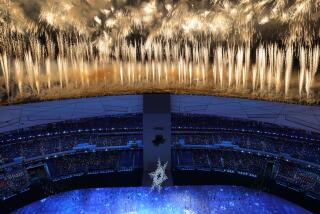Hoopla Marks Centennial of Mao’s Birth : China: The late leader and foe of capitalism probably would have conniptions over the commercialization tied to his Dec. 26 birth date.
- Share via
BEIJING — His face is on pink yo-yos. He gazes from diamond-studded watches. Mao Tse-tung’s image has been affixed to all kinds of products in a rush to cash in on the centennial of his birth.
Spin the yo-yos and they play the Communist standard, “The East Is Red.” So do Mao cigarette lighters. There is a compact disc of Mao’s greatest hits--seven of the late leader’s speeches for an evening of listening pleasure.
Miniature bronze Mao statues, gold and silver commemorative coins and gold-gilded souvenir Mao badges are all for sale.
And there are Mao timepieces to fit anyone’s budget.
The equivalent of $10 will get you a basic watch, its face showing a portly Mao in front of Tian An Men Square. More than $1,000 buys a watch decorated with a golden likeness of Mao, diamonds and sapphires. (Act now, there are only 9,999 copies.)
No proletarians need consider the granddaddy of commemorative items, a gold pocket watch adorned with a platinum Mao image, 36 diamonds, a ruby and four sapphires. Prices for the limited edition of 99 watches range from $17,888 to $19,388, depending on whether the serial number is considered lucky.
Mao, who spent his life fighting capitalism, probably would have conniptions over the commercialization tied to his Dec. 26 birth date. But as an eager orchestrator of momentous events, he likely would be pleased by a media blitz that is painting him in a favorable light.
There have been countless reminiscences in official newspapers describing Mao as a benevolent grandfather and plain-living man rather than the ruthless leader whose misguided agricultural policies and brutal political purges caused millions of deaths.
We find out from a personal cook, Wang Jinren, that Mao disliked seafood but loved chilies and garlic.
From his bodyguard, Li Yinqiao, we learn Mao was no clotheshorse. “From his underwear to his coat, from his upper outer garments to the soles of his shoes, everything was patched and patched again.”
A series titled “Places Chairman Mao Visited,” a Chinese version of “George Washington Slept Here” vignettes, has appeared in China’s leading daily. Another newspaper listed the dates, locations, weather conditions and length of Mao’s 13 swims in the Yangtze River.
Inquiring minds who want to know more can choose from dozens of new books on Mao.
On a recent morning at Beijing’s main bookstore, a steady stream of people snapped up Mao histories and collections of his poems and photos. A hot seller was a tellingly slim volume on his sense of humor.
The renewed interest in Mao has even led to a rash of reported discoveries of mountain peaks said to resemble the “Great Helmsman.”
Despite the hoopla, official activities have been mostly limited to seminars, discussions and exhibitions--including one that displayed 30-year-old raisins and sunflower seeds given to Mao by ethnic minority groups.
“Mao fever” has been hottest in his southern hometown, Shaoshan, which is putting up a larger-than-life bronze statue, setting out 20,000 pots of flowers and holding a marathon, a variety show and a fireworks display. But officials rejected a suggestion to whitewash all houses, showing concern that commemorative activities not go too far.
More to Read
Sign up for Essential California
The most important California stories and recommendations in your inbox every morning.
You may occasionally receive promotional content from the Los Angeles Times.













